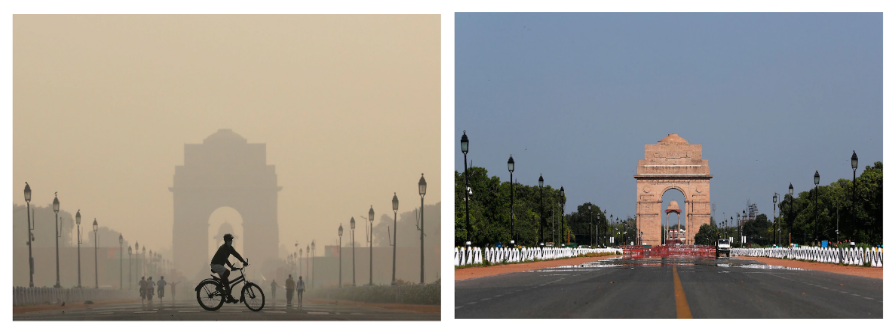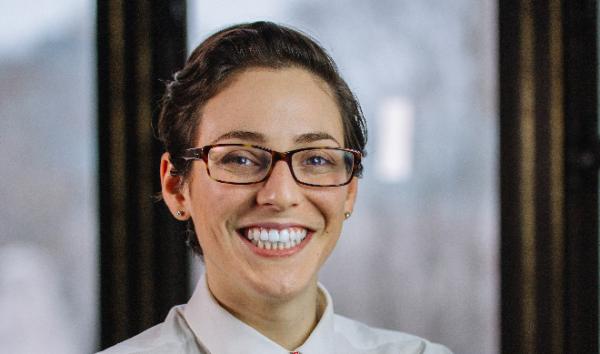
Date:
A now famous before/after image of the New Delhi War Memorial showing air quality improvements. Left: October 17, 2019. Right: April 18, 2020. (Anushree Fadnavis and Adnan Abidi/Reuters)
“The air is clear, the skies are blue. I see the evening stars with clarity....” Smita Tharoor told The Guardian newspaper last week as she marvelled at New Delhi’s new skyviews. Like millions of others, Smita is revelling in the rapid improvements of air quality seen the world over.
In the wake of the COVID-19 pandemic, global industry and life as we know it has all but grinded to a halt. With the rapid drop in transportation, energy production, and industrial activity, city dwellers around the world are suddenly breathing easier. Air particulate counts have plummeted as have concentrations of harmful gases like ground-level ozone and nitrogen dioxide (NO2). Here in the northeast U.S. we’re benefitting from these improvements, too. NASA reports our region is registering a 15-year low in NO2, a byproduct of burning fossil fuels.
Journalists and scientists alike have been quick to celebrate these drastic improvements in air quality and laude them as proof that countries can rapidly achieve climate action goals. Indeed, 2020 is on track to see a 3% reduction in global carbon emissions from last year, a notable value to be sure. (Though note that double that value is needed to reach carbon neutrality by 2050 and that there could be a sudden surge to business-as-usual conditions when the economy opens back up.)
Given the personal hardships that have accompanied this economic slowdown, it seems undue to celebrate these air quality improvements. Simultaneously, ignoring the ever-present threat of climate change feels equally inappropriate. No matter how we parse it, addressing the COVID-19 pandemic must take precedence, but addressing one threat does not resolve another. Like a movie projected onto a moving background, our COVID-19 response is playing out on top of the climate change saga.
How can we advance beyond this impasse? I’m inspired by author and director Julio Vincent Gambuto, who referred to this moment as “The Great Pause.” Insofar as we can access the capacity to do so, we are presented with an opportunity to reflect on a world frozen in time. This is a chance to examine life as it was and what we want it to become. The Great Pause giving way, so to speak, to a great transformation.
It’s the kind of “transformational change” that the Intergovernmental Panel on Climate Change calls for and will be necessary to avoid the worst climate impacts. Indeed, analyzing the global COVID-19 response yields many insights that we can apply to becoming more resilient in the face of climate change. Here are three insights I’ve been thinking about:
COVID-19 isn’t the great equalizer, and neither is climate change. While this virus doesn’t discriminate among ages, nationalities, and races, people are impacted nonuniformly: across the country people of color and the economically disadvantaged are more likely to be afflicted with and die from this disease. Similarly, climate change will be felt hardest by the most vulnerable among us. Collectively, COVID-19 and climate change lay bear and exacerbate existing inequities within our communities (albeit on different timescales). Communities most resilient to future threats from viruses and climate impacts alike will prioritize investments and policies that address inequity.
Individual action works, but collective action works better. To protect ourselves from contracting COVID-19, we’re taking individual precautions like frequent hand washing and wearing a protective facemask. The most effective tool to combat the spread of coronavirus, however, has proven to be social distancing (consider the strict city-wide restrictions established in San Francisco that tamped down the rapid spread of cases observed in other densely populated cities). Just as slowing the spread of coronavirus requires all of us to take action together, so too does solving climate change. Individual actions can only do so much, and our true power in creating a sustainable, resilient world is only realized in the aggregate. To learn more, check out Project Drawdown (https://drawdown.org/solutions).
Our future world is not yet realized. Science-informed decision making remains our best tool to chart the course we want to take. Quick, decisive decision making informed by epidemiologists and public health experts has saved lives (see San Francisco example above). Climate scientists are analogously “earth health” experts and their diagnosis is painfully clear: taking precautionary steps will reduce suffering. Of course the greatest unknown in any future scenario remains human behavior. Do we use this moment to reflect on how to change for the better and move permanently into new lifestyles, or do we throw caution to the wind, bounce back and go bigger and “better”?
I don’t know about you, but I’m using this moment to look upwards and outwards. After all, it’s nice to see the stars.


